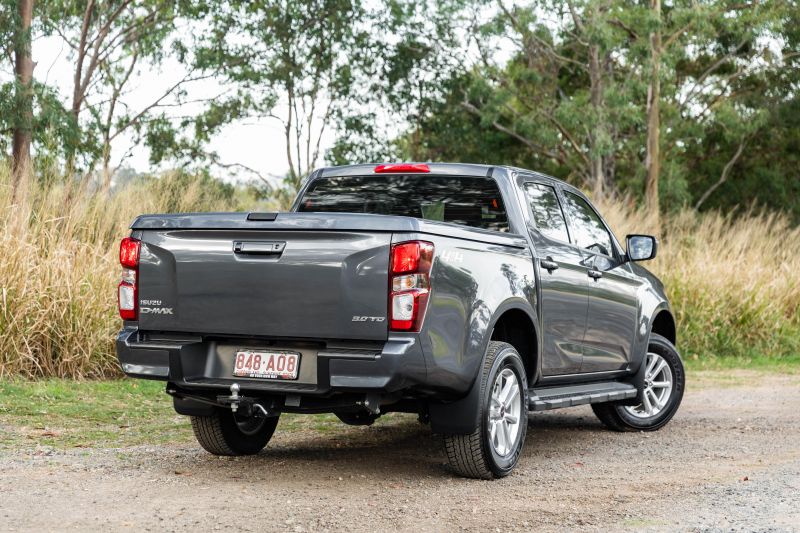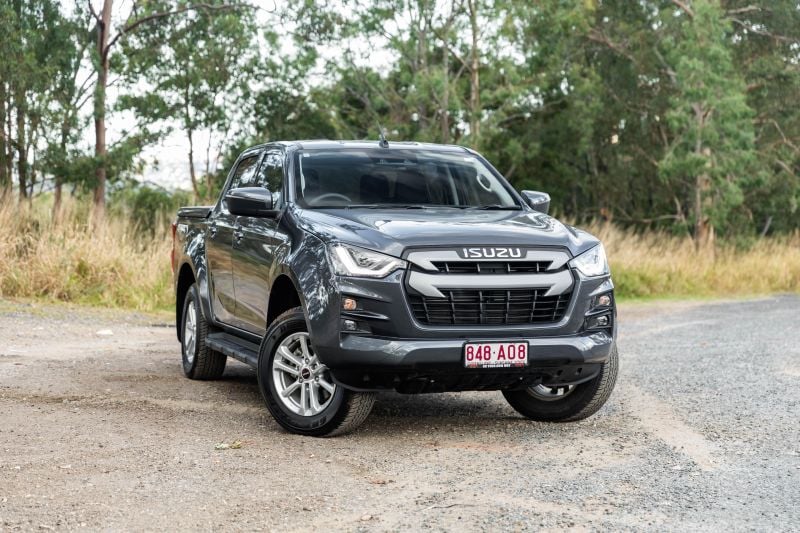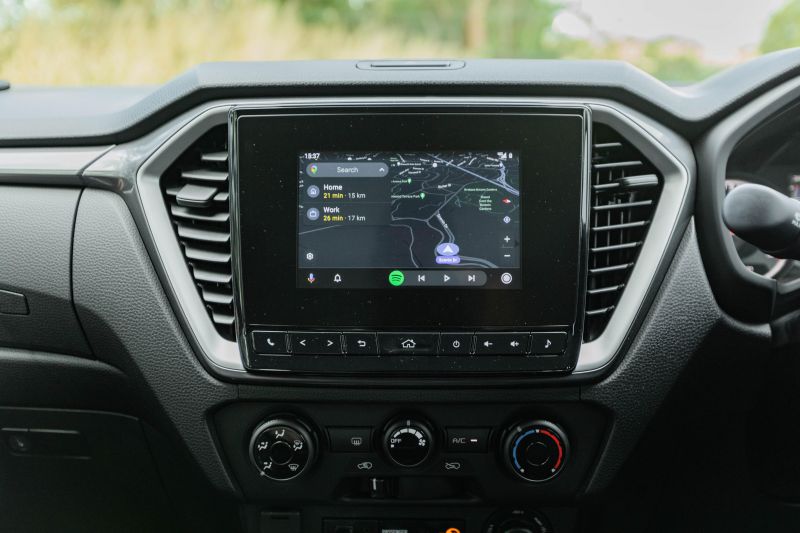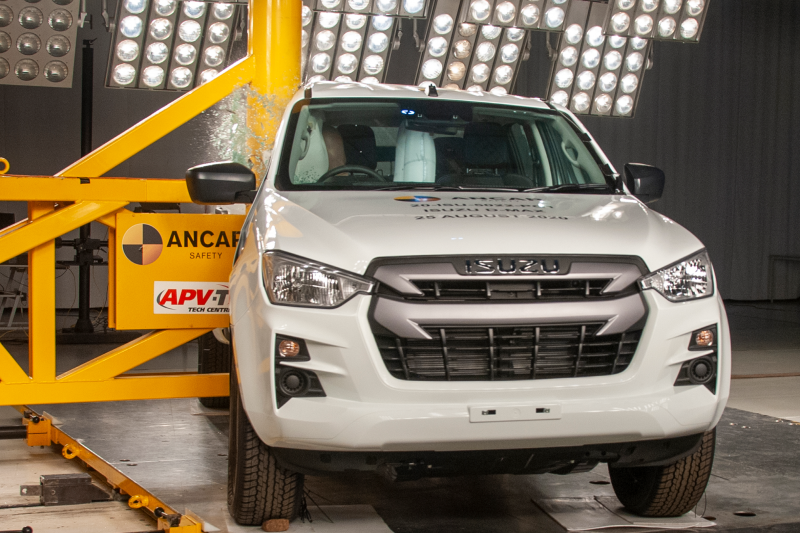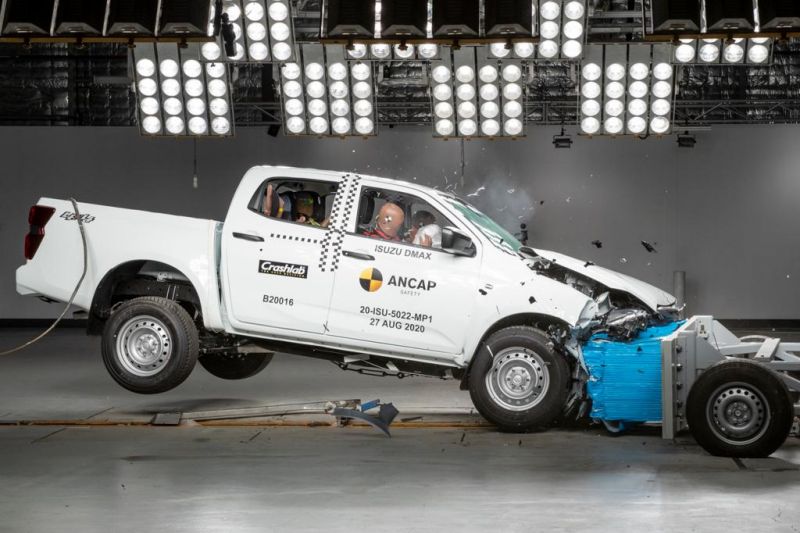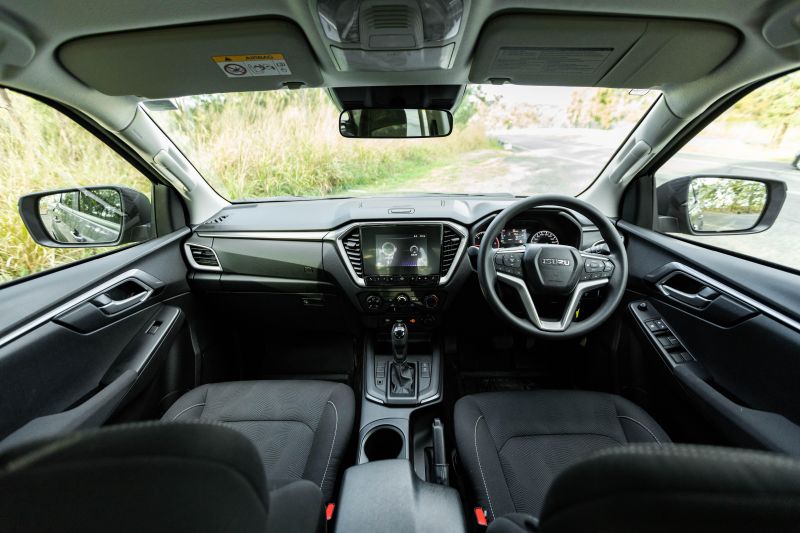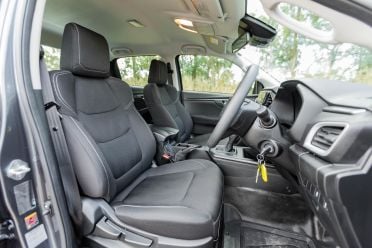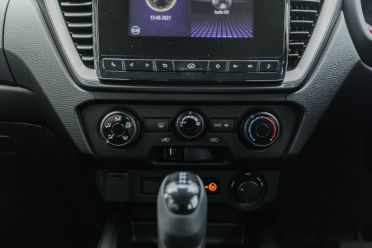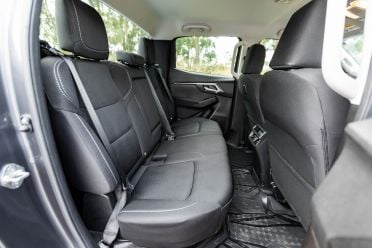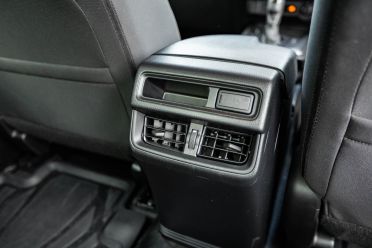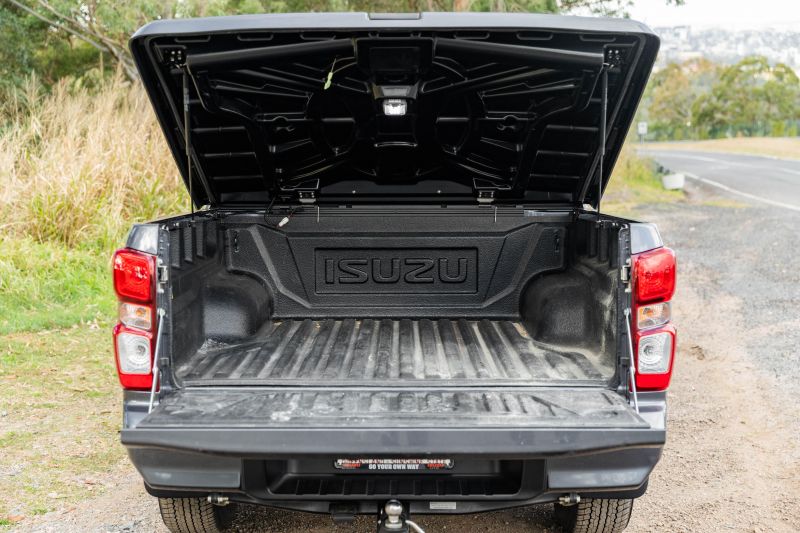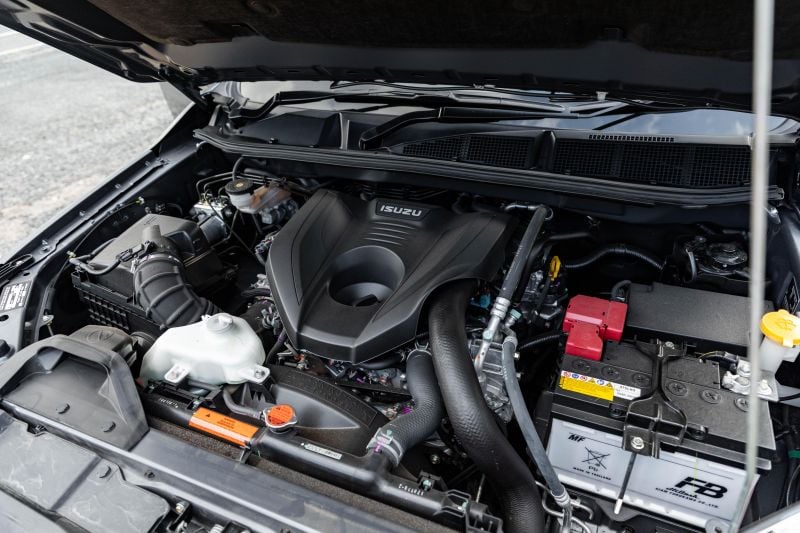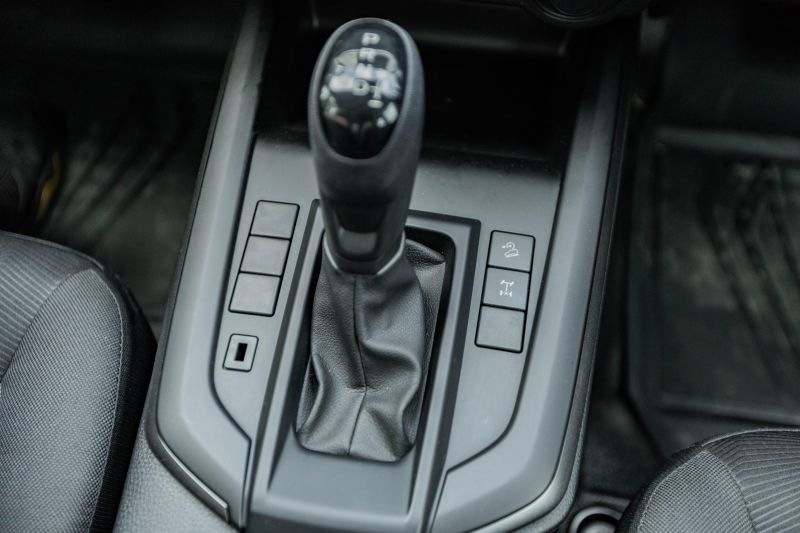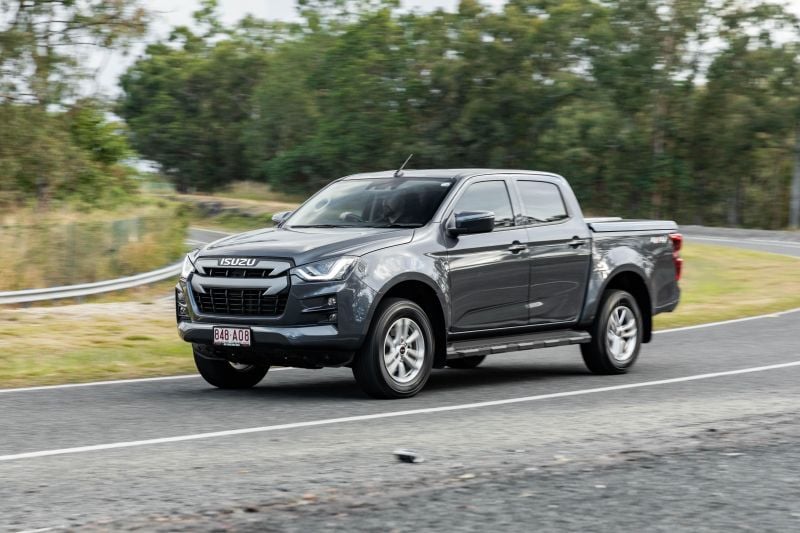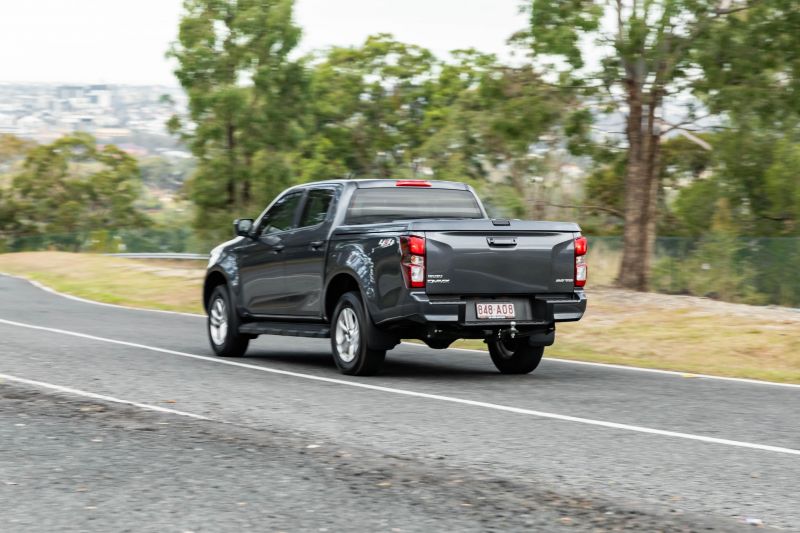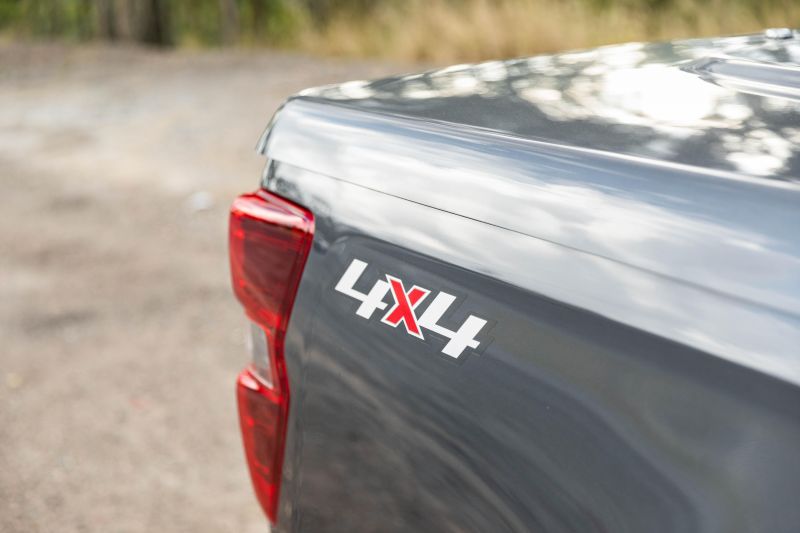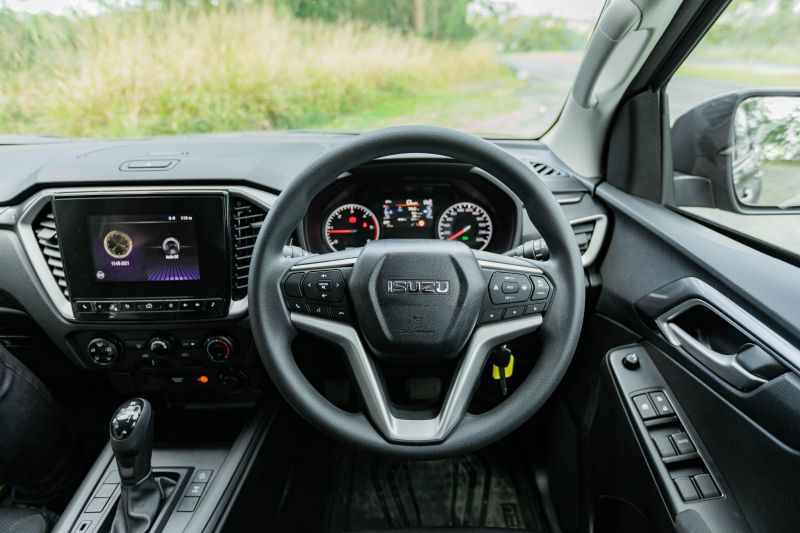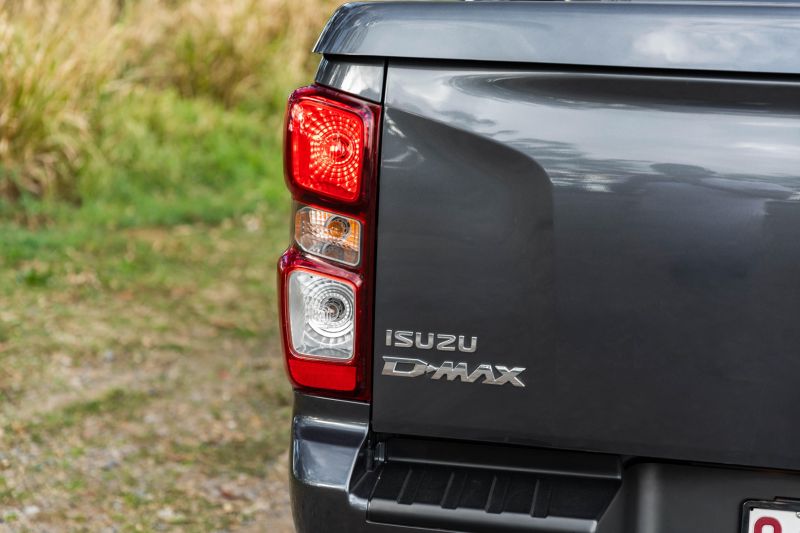Isuzu seems to have hit the sweet spot with its redesigned D-Max.
Raising prices by thousands of dollars hasn’t scared off customers, with sales up by more year-to-date than any other rival.
In fact, waiting lists have blown out for some variants like the range-topping X-Terrain, as the company has struggled with supply issues.
Isuzu Ute Australia doesn’t want this to be a mere sales sugar high. Instead, it wants to remain a permanent fixture on the ute sales podium.
It’s already managed that feat once before, having toppled the perennial third-place Mitsubishi Triton back in June, despite being pricier than the Mitsubishi.

How much does the Isuzu D-Max LS-M cost?
Our tester is a dual-cab 2021 Isuzu D-Max LS-M with the optional automatic transmission, priced at $54,000 before on-road costs. Options fitted include hard tonneau cover ($2999) and Obsidian Grey mica paint ($500), bringing the total to $62,426 drive-away based on a Sydney postcode.
Other colours include Basalt Black, Mercury Silver, Cobalt Blue and the standard Mineral White.
Comparably specified 4×4 dual cab utes include the Toyota HiLux SR ($52,795 before on-roads), Mazda BT-50 XT ($53,260 list) and Ford Ranger XLS ($52,490 list).
You can get more creature comforts for your money if you look at the Mitsubishi Triton and Nissan Navara. While a Triton GLX+ ($43,690 drive-away) broadly matches the D-Max LS-M in equipment (safety tech aside), a top-spec GSR can be had for $53,240 before on-roads or $57,240 drive-away.
Likewise, the Navara SL is relatively close to the D-Max LS-M in terms of equipment and is priced at $49,100 before on-roads. But step up to the ST, which adds various niceties and matches the D-Max for safety equipment, and you’re still looking at $54,780 before on-roads.
Then there are the even cheaper Chinese and Korean utes. A top-spec GWM Ute Cannon-X is just $41,990 drive-away, while a SsangYong Musso Ultimate is $41,290 drive-away.
It’s clear the Isuzu occupies a pricing tier with the likes of the HiLux and Ranger, though it’s arguably better value than either.
What do you get?
The LS-M is one step up from the base “traffic controller” SX, and adds the following equipment:
- ‘High-grade’ cloth upholstery
- Rear USB connector
- Seatback pockets
- Fold-down centre armrest
- Six-speaker sound system
- Bi-LED headlights
- LED daytime running lights
- Body-coloured mirrors
- 17-inch alloy wheels in Dunlop 255/65 R17 all-terrain tyres
That’s over the SX’s equipment list, which includes:
- 7.0-inch touchscreen infotainment system
- Apple CarPlay (wireless) and Android Auto (wired)
- 4.2-inch trip computer display
- Manual air-conditioning
- Automatic headlights
That means you need to press a key fob to unlock or lock the D-Max, and turn a key in the ignition to start it. The flooring is rubber instead of carpet, and there’s no leather-wrapped steering wheel or shifter like in the LS-U and X-Terrain.
The LS-M also misses out on those variants’ padded dash-top and centre console bin lid. It also misses out on satellite navigation, exclusive to those up-spec models which have a larger 9.0-inch touchscreen.
The feature list may therefore not be as long as the likes of the Musso or GWM Ute, but the D-Max has some cards to play. It’s one of only two utes – the other being the BT-50 – to offer wireless Apple CarPlay, for instance. Additionally, you need to step up to a Ranger XLT or a HiLux SR5 to get LED headlights in those model lines.
One notable absence is the lack of rear parking sensors, which can be found on all Ranger utes.
There’s one member of the ute ‘establishment’ that manages to match the D-Max for safety equipment but offers more niceties, and that’s the Navara ST. It includes satellite navigation, a leather-wrapped steering wheel and shifter, and DAB+ digital radio among its equipment list.
Is the Isuzu D-Max LS-M safe?
So far, the D-Max LS-M is looking quite close to the Ranger XLS and HiLux SR in terms of standard equipment. It’s in the safety stakes, however, where the Isuzu claws back some ground.
Quite simply, the D-Max (and its BT-50 twin) obliterate the two best-selling utes in terms of standard safety technology.
Every model comes standard with the following safety features:
- Autonomous emergency braking
- Blind-spot monitoring
- Driver attention monitoring
- Forward collision warning
- Lane-departure warning
- Rear cross-traffic alert
- Turn assist
- Traffic sign recognition
- Automatic high-beam
- Reversing camera
Automatic models also add wrong-pedal acceleration warning, adaptive cruise control, and lane-keep assist.
Eight airbags are standard, including a front-centre airbag designed to stop the passenger and driver’s flailing arms and heads crashing into each other in a serious side-impact crash.
The GWM Ute essentially matches this list of equipment at a lower price, mind you, while also offering a sophisticated surround-view camera, but it has some other drawbacks – more on that later.
No HiLux or Ranger offers blind-spot monitoring or rear cross-traffic alert and, while these features are standard in the Triton GLS and GSR, the Mitsubishi misses out on lane-keep assist and traffic sign recognition. Only the Navara ST offers a comparable level of safety equipment among the ute establishment, also including a surround-view camera.
The D-Max and BT-50 also offer a five-star ANCAP rating under the most recent testing protocols. The GWM Ute, at the time of writing, has yet to be tested due to COVID-19 lockdowns, while the other utes offer five-star ratings albeit under older testing protocols.
The D-Max’s five-star rating was based on an adult occupant protection score of 83 per cent, a child occupant protection score of 89 per cent and a safety assist score of 81 per cent. Vulnerable road user protection testing yielded a score of 69 per cent.
What is the Isuzu D-Max LS-M like on the inside?
The D-Max LS-M’s interior is logically laid-out, no-nonsense and modern in appearance.
Instead of a 9.0-inch touchscreen like the LS-U and X-Terrain, there’s a 9.0-inch surface area inside which sits a 7.0-inch screen surrounded by a thick bezel. At least you still get wired Android Auto plus, rare for this segment, wireless Apple CarPlay. There’s no factory satellite navigation, though.
A colour 4.2-inch information display sits between the analogue dials of the instrument cluster and displays information on, among other things, fuel economy and the active safety systems.
While the dials are clear and legible, the information display is a bit cluttered. Fortunately, it boasts a digital speedometer, something you won’t find in a Triton.
The highlight of the interior are the front seats, which are cushy and comfortable yet supportive.
There’s plenty of storage up front, including a split-level glove compartment, neat pop-out cupholders on either end of the dash, a reasonably-sized centre console bin, a tray at the base of the centre stack large enough for a phone, and a dash-top tray with a lid that can also fit a phone.
Each door has a bottle holder that’ll fit a typical drink bottle, while stepping into the back you’ll find map pockets on the soft seatbacks plus a small, open cubby above the air vents. It sits next to a USB-A outlet.
Rear legroom, headroom and toe-room is par for the dual-cab ute class, with plenty of room for even taller occupants.
The second-row bench folds upwards at its base to reveal storage beneath the seat, while it can also be folded to access a shared top-tether anchor point for child seats. ISOFIX points are accessible for the two outboard seats.
One downside of the cabin is the driver’s footrest, which is too narrow. Another bugbear we experienced was a squeak when we turned the steering wheel, though fortunately there were no other noticeable build quality issues.
The tub measures 1570mm long at the base, 490mm deep, and has a maximum width of 1530mm. This narrows to 1122mm between the wheel houses.
Those figures aren’t dramatically different from a HiLux (1570mm x 481mm x 1645mm and 1109mm between the arches) or a Ranger (1549mm x 511mm x 1560mm and 1139mm). All three utes have a longer and wider tub than a Triton.
What’s under the bonnet?
The D-Max is powered by a 3.0-litre four-cylinder turbo-diesel engine producing 140kW of power and 450Nm of torque. It’s available with a six-speed manual or six-speed torque-converter automatic transmission, though our tester was equipped with the latter.
The new 4JJ3-TCX engine is up 10kW and 20Nm on the 3.0-litre mill in the old D-Max. In terms of outputs, though, it’s still mid-pack – the HiLux’s 2.8-litre puts out 150kW and 500Nm, while the Ranger’s 3.2-litre five-cylinder puts out 147kW and 470Nm and its 2.0-litre twin-turbo four puts out 157kW and 500Nm.
It’s lineball with the 2.3-litre twin-turbo in the Navara (140kW/450Nm) and has greater outputs than the Triton (133kW/430Nm).
The D-Max has a braked towing capacity of 3500kg, identical to the likes of the HiLux SR and Ranger XLS, and has a 350kg maximum down ball load.
Payload is 1070kg in the LS-M, against 991kg for the Ranger XLS and 995kg for the HiLux SR.
The engine is mated to a part-time four-wheel drive system that defaults to rear-wheel drive and offers both high- and low-range gearing plus a locking rear differential. There’s no full-time four-wheel drive mode like you’ll find in, for example, a Triton GLS.
Its approach angle is 30.5 degrees, departure angle is 24.2 degrees, and ramp-over angle is 23.8 degrees, while Isuzu claims an 800mm wading depth.
How does the Isuzu D-Max LS-M drive?
The D-Max’s turbo-diesel is torquey and tractable. It pairs wonderfully with the six-speed auto, which ably keeps it in its torque band and shifts smoothly.
There’s also a lack of turbo lag, while peak torque comes on tap at just 1600rpm and sticks around until 2600rpm.
There’s the typically gruff diesel ute soundtrack under acceleration, but at cruising speeds it’s pleasant. Wind and road noise are kept largely in check, even at highway speeds.
The electrically-assisted steering is pleasantly light and car-like without feeling vague. It’s a boon in tighter urban confines, and the D-Max feels more manoeuvrable than rivals with hydraulic set-ups. The steering also feels secure even as speeds increase.
The D-Max’s ride quality is among the best in the segment, with the usual ladder-frame ute jiggles kept to a minimum even with an empty tub. Those jiggles are further quelled when you put even a small load back there.
At high speeds on unsealed roads, the D-Max has a comfortable, sure-footed ride, even with an empty tub.
The blind-spot monitoring works well and is absolutely welcome, particularly in a segment where this feature remains rare. The lane-keep assist isn’t too obtrusive, while the adaptive cruise control also performs admirably. You can also adjust the sensitivity of some of these systems, including the forward collision warning.
What’s most impressive about the D-Max is that the steering, ride quality and noise levels don’t get noticeably worse as your speeds get higher, meaning this is a comfortable highway cruiser.
Overall, the capable powertrain, light steering and mostly well-behaved ride makes this one of the better utes to drive.
How much does the Isuzu D-Max LS-M cost to run?
The D-Max is backed by a six-year, 150,000km warranty, and comes with seven years of roadside assist.
Servicing for the D-Max is required every 12 months or 15,000km, whichever comes first. The first seven years of servicing will cost you a combined $3373, broken down below.
- 15,000km: $389
- 30,000km: $409
- 45,000km: $609
- 60,000km: $509
- 75,000km: $299
- 90,000km: $749
- 105,000km: $409
That’s relatively par for the course for the segment, with a cost for the first five years of $2215. That’s $380 less over the first five years than a Triton and $632 less than a Navara.
The Ranger is considerably cheaper, however, at $1586 over five years, while a Navara has longer servicing intervals of 12 months or 20,000km.
In terms of fuel consumption, Isuzu claims a combined fuel economy rating of 8.0L/100km.
We managed 8.7L/100km on our loop, comprising inner-city, suburban and highway driving, and with no load in the tub. Over the course of a week, this increased to 10.4L/100km, however this was heavily skewed towards urban driving.
CarExpert’s Take on the Isuzu D-Max LS-M
The Isuzu D-Max may have marched upwards in price but the hike is easier to swallow when you consider just how much technology has been added.
You can find a similarly lengthy list of safety equipment in a GWM Ute, but it has yet to earn a vaunted reputation for reliability like the Isuzu.
While the D-Max, on paper, has less power and torque than a HiLux or Ranger, in the real world this slight deficiency is scarcely noticeable. The D-Max boasts one of the best powertrains in the segment.
Its interior is also comfortable and modern, though there are some obvious signs you didn’t shell out for the LS-U or X-Terrain, such as the thick bezel around the touchscreen and the lack of a leather-wrapped wheel.
Overall, the D-Max has taken a big step up with the latest generation. Isuzu wants it to be one of the top three best-selling utes in Australia, and it certainly deserves to be up there.
Click the images for the full gallery
MORE: Everything Isuzu D-Max






